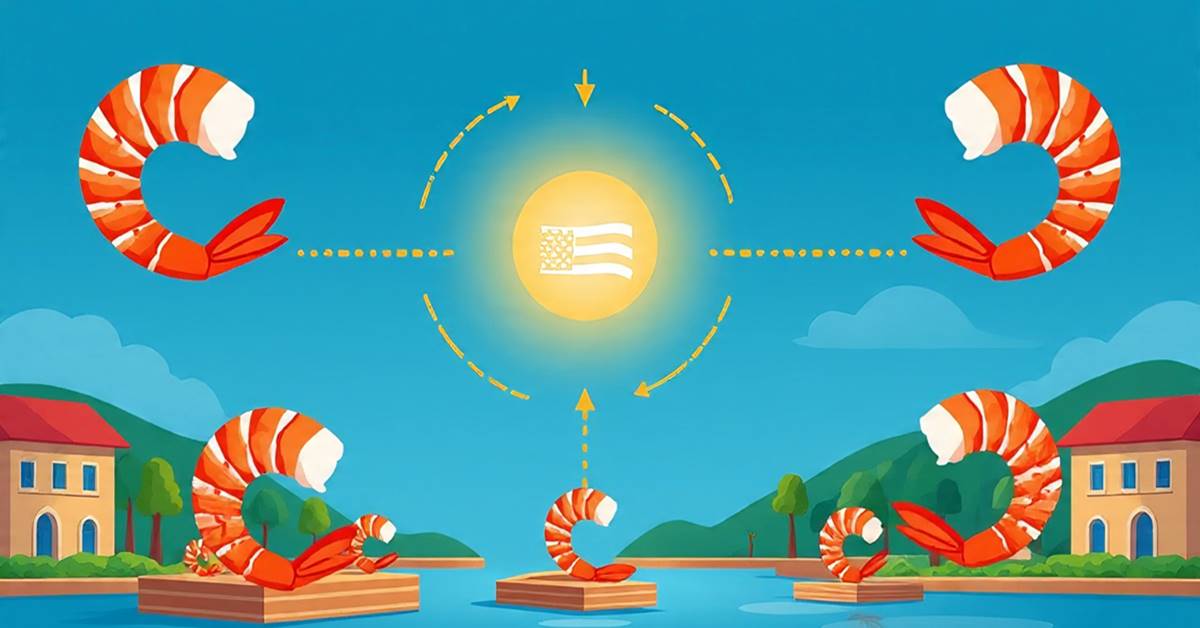Your cart is currently empty!

From U.S. Setback to China Boom: The New Chapter for Indian Shrimp Trade
Trade wars and tariffs often shake up global markets, and the Indian shrimp industry is a clear example of this. For decades, the United States was India’s largest buyer of shrimp. However, with the imposition of steep tariffs and stricter trade barriers, exporters faced shrinking margins and declining demand. What seemed like a major setback turned into a surprising opportunity: China stepped in as a new growth market, giving Indian shrimp a fresh lifeline.
This shift is reshaping the seafood trade, diversifying India’s export base, and teaching valuable lessons about resilience in global commerce.
The U.S. Tariff Shock
The United States imposed higher duties on shrimp imports from India, citing anti-dumping concerns and trade imbalances. These tariffs immediately made Indian shrimp more expensive and less competitive in the U.S. market. Exporters reported narrower margins and reduced orders, leaving them scrambling to protect their businesses.
For an industry that had heavily relied on one market, the challenge was clear: adapt quickly or risk collapse.
China Steps In as a Savior
When one door closed, another opened. China, with its vast seafood demand and processing capabilities, became the unexpected savior. Its growing appetite for imported shrimp provided Indian exporters with a strong alternative.
The shift was not just about redirecting shipments but also about reconfiguring supply chains, meeting Chinese import standards, and building new trade relationships.
Why China Became the Go-To Market
| Factor | Explanation |
|---|---|
| High Domestic Demand | China’s population and seafood culture drive continuous demand for shrimp. |
| Processing Infrastructure | Chinese ports and processors handle large seafood imports efficiently. |
| Favorable Trade Alignment | Lower tariffs and quicker approvals compared to U.S. restrictions. |
| Strategic Diversification | Provides Indian exporters relief from over-dependence on the U.S. market. |
Early Results of the Shift
The initial data indicates that the redirection of exports has helped stabilize India’s shrimp industry. While the U.S. still buys significant volumes, the dependency is no longer absolute. Exporters now benefit from a dual-market presence, balancing risks and securing more consistent revenue.
Impacts at a Glance
| Impact Area | Positive Outcomes | Challenges |
|---|---|---|
| Revenue | Maintained export earnings despite U.S. slowdown | Margins can be tight due to logistics |
| Production | Shrimp farms continue full operations | Quality control investments needed |
| Market Diversity | Reduced reliance on U.S. buyers | Dependence on Chinese regulations is risky |
| Standards | Push to improve packaging and traceability | Upgrading supply chains costs more |
Pros of the New Market Shift
- Diversification of Buyers – Reduces the risks of relying too heavily on one market.
- Sustained Industry Growth – Shrimp farms and processing units continue to operate at capacity.
- Scope for Expansion – China’s vast demand allows room for future growth.
- Improved Standards – Pressure to meet Chinese requirements is driving higher quality.
- Geopolitical Leverage – With multiple buyers, India gains bargaining power in global seafood trade.
Cons and Risks to Consider
- Regulatory Uncertainty – China’s import policies can change abruptly.
- Thin Margins – Costs for logistics, compliance, and cold chain investments eat into profits.
- Market Saturation – Over-reliance on China could create a similar dependency as before.
- Currency Volatility – Exchange rates can impact final earnings.
- Small Exporter Challenges – Not all exporters have the resources to pivot quickly.
Long-Term Outlook for Indian Shrimp
The pivot toward China may prove to be more than a stopgap. Over time, it could reshape India’s seafood strategy by encouraging:
- Permanent Market Diversification – Expanding further into Southeast Asia, the Middle East, and Europe.
- Value-Added Products – Moving beyond raw exports to cooked, packaged, and branded shrimp.
- Improved Cold Chain & Processing – Investments in infrastructure for global standards.
- Resilience Against Trade Shocks – Stronger immunity to sudden policy changes in any single market.
If managed well, the current shift could mark the beginning of a new, more balanced era for Indian seafood exports.
Honest Review of the Situation
The situation truly is a “blessing in disguise.” While tariffs disrupted old patterns, they forced the Indian shrimp industry to evolve. The new China connection ensures that exporters are not left stranded. At the same time, it highlights the importance of spreading risks and not putting all eggs in one basket.
In the future, success will depend on how well India leverages this momentum—whether by diversifying into more countries, moving up the value chain, or strengthening its domestic processing capacities.
Conclusion
The U.S. tariffs were a setback, but India’s shrimp exporters turned adversity into opportunity. By tapping into China’s seafood demand, they found stability, resilience, and new growth pathways. The journey is not without challenges, but the industry has demonstrated adaptability—a quality that will be critical in the uncertain world of global trade.
Disclaimer
This article is intended for informational purposes only. It reflects trade trends and industry observations. Readers are encouraged to verify policy updates, market conditions, and pricing from official trade and government sources before drawing conclusions.
